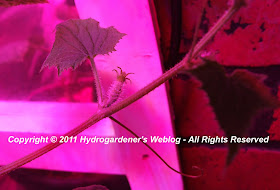

While my assistant harvested the rhubarb chard I was busy transplanting the Early Wonder beet seedlings into netpots. Although Ava is only four, she has at least two years experience in hydroponic gardening. She can pick up tiny seeds with her small fingers, and as her eyes can focus at incredibly close distances, she can plunk them into growing cubes faster than I can. I am considering raising her salary from five to eight cents an hour.
I am going to wear out the zipper on the tent looking at the Balcony Hybrid tomato plant as it flowering like mad. I have had the seeds for this variety for several years, but have never grown any, so I have no idea of what to expect other than what is says on the package.
A horizontal support has been provided for the cucumbers in the AutoPots, as they are getting too close to the light and I can not raise the light any higher. I am going to let them grow a short distance horizontally, and then point them downward again, kind of like an inverted U. Still, they are only producing male flowers. It beats me as to why a plant that does not need male flowers to set fruit would produce so many of them.
I can't help but think ahead of what I am going to grow next with the six band flower series light. Giant Marconi peppers would be my first choice, but using it with an active system, such as my modified aeroponic system is also an interesting possibility.
The folks at Pro LED Systems have developed a great product, and I wish them success in launching it in this difficult economic environment. To make matters more difficult, there are people purporting to be experts populating gardening forums that denigrate LED lighting, and in some instances all artificial lighting. I lifted this quote from a guy who calls himself Durgan at the Idigmygarden forum: "artificial light leaves a lot to be desired, expensive and inadequate for most plants to produce other than a bit of vegetation or greens.
" On another forum, someone was pretending to have this vast knowledge of the physics of plant lighting and expounding why photons, produced by LED lighting, would not penetrate a plant, and therefore LED lighting was useless. The sad thing is that many of the people participating in the forums are new to hydroponic gardening and take this drivel as gospel.

















































